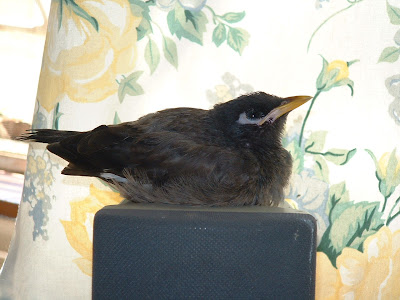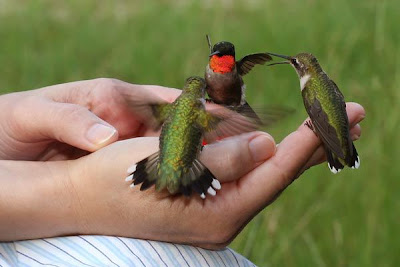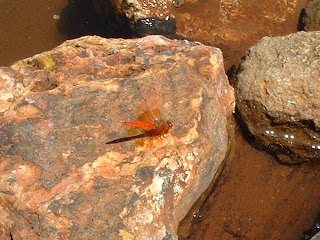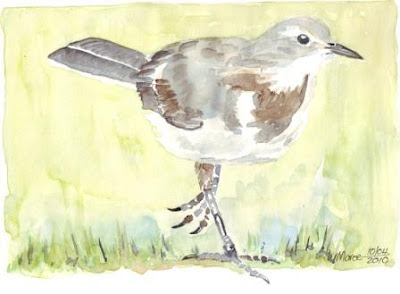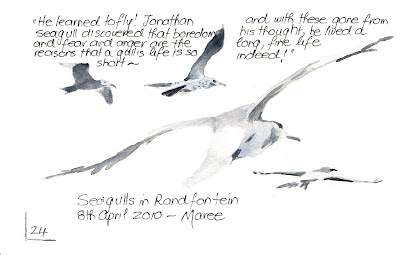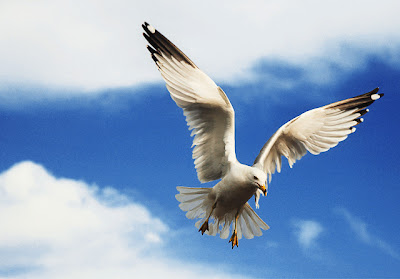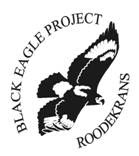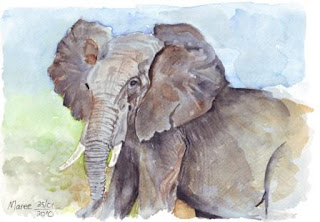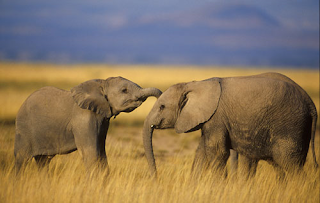 One of the sketches I did of our blue gum forest in my Moleskine watercolour Sketch-book
One of the sketches I did of our blue gum forest in my Moleskine watercolour Sketch-bookIn the past couple of weeks I've had to temporarily give up my sojourns into our Blue gum forest at the bottom of our property where I go to sketch and paint, due to all the rain we've had, which has resulted in a larger than normal number of snakes that I encounter while trying to settle in to sketch.
While you're concentrating on a specific tree, it's rather disconcerting hearing the leaves rustle and then seeing a Rinkhals (Spitting Cobra) nonchalantly sailing in your direction. It means either sitting dead still, hoping he's not going to notice you, or it's a mad scramble trying to get out of the way (and then alerting him to your presence), sending easel or sketchbooks and water flying through the air!
In the past 2 weeks I have already rescued and evicted two Rankhalses from my garden (the pleasure of my garden only to be enjoyed by Mollie, my resident Mole Snake or the Brown House Snake - all others like the Rinkhals and the various Adders are summarily evicted!). Chrissie, my gardener, immediately takes a short-cut home when she sees I'm busy catching a snake for safe delivery to a dam nearby us.
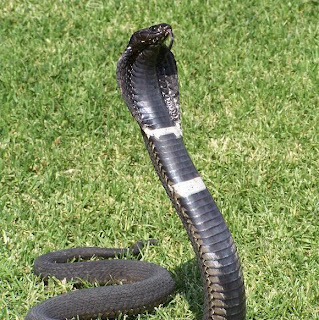 Rinkhals - Hemachatus haemachatus
Rinkhals - Hemachatus haemachatusThe Rinkhals is a member of the Cobra family and is also a spitting cobra. It is the smallest of the cobras reaching only about 1.2m or about 4 ft in length. It is a venomous elapid species found in parts of southern Africa. It is one of a group of cobras that has developed the ability to spit venom as a defense mechanism. Rinkhals are unique amongst African cobras in being ovoviviparous. They give birth to 20-35 young, but as many as 65 babies have been recorded. The Rinkhals is unique also, compared to cobras, as it has keeled scales.
The spitting range is up to 2,5 m. If venom enters the eye it should be washed out immediately, to prevent damage to the eye. The venom of the Rinkhals is neurotoxic - causing nervous dysfunction - and it can cause death from respiratory paralysis, although this is rare. Anti-venom is an effective antidote against the toxin.
 Rinkhals feigning death
Rinkhals feigning deathIf cornered, a Rinkhals will feign death and will roll over on it's back melodramatically, open it's mouth and let the tongue hang out, all this to discourage whoever may be hovering over it - heaven forbid you touch it then! It will either make a sudden getaway or give a nasty bite. I have witnessed this behaviour personally and I must tell you, it's utterly convincing!
Although sometimes seen on cloudy days, it is mainly nocturnal and feeds mostly on small vertebrates, especially toads. It is closely related to cobras, but its scales have a prominent central ridge or keel, and are not smooth.
Rinkhals can be variable in colour but most specimens are olive, brown or black in colour with a creamish, yellowish or white cross bands on the ventral side of the neck. The belly is mostly greyish or dark coloured. Some specimens are brownish or blackish from colour with on the back white, creamy or yellow-orange cross-bands the ventral side is still dark coloured and these individuals still have the white cross bands on the throat. The body is short and strongly build, the Rinkhals cobras scales are keeled which makes him the only African Elapid with keeled scales.
The uniform brown colour resembles the mole snake, which does not, however, rear up and spread a hood. However, it will lift itself slightly off the ground to get a better view, as you can see from my photograph of Mollie below.
 Mollie, my resident Mole Snake at the pond while it is being cleaned, wondering what all the ballyhoo is about!
Mollie, my resident Mole Snake at the pond while it is being cleaned, wondering what all the ballyhoo is about!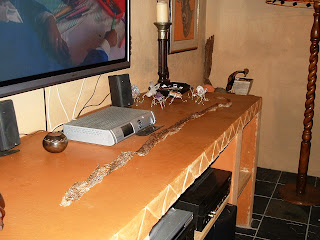 Mollie dropped her skin a couple of weeks ago, 1.7m! which now takes pride of place in front of the TV. Unnecessary to say, Lydia refuses to even dust this area, a job which is now left up to me.
Mollie dropped her skin a couple of weeks ago, 1.7m! which now takes pride of place in front of the TV. Unnecessary to say, Lydia refuses to even dust this area, a job which is now left up to me.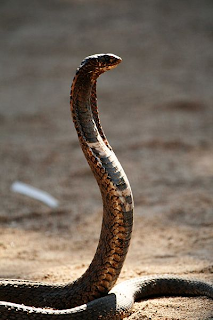 Rinkhals rearing up
Rinkhals rearing upThis species is only known from Southern Africa. It occurs in isolated populations in Zimbabwe and Mozambique. In South Africa is this snake known from the south cape through Swaziland, Orange Free State, Natal, Transkei, Lesotho and Southern Transvaal.
This snake is mostly found in grassland and moist savanna. But will also live in rocky areas and near humans. They are also known to live close to permanent water holes and scrub.
In the wild do Rinkhals mostly eat toads but also small rodents, birds, lizards and even snakes. In captivity can Rinkhals been fed on dead or live rodents which they often take without a problem. Also chicks and eggs are known to be accepted in a captive situation.
The Rinkhals, the Mozambican Spitting Cobra and the black necked spitting cobra, are the only snake species in southern Africa that 'spit' venom. The Rinkhals is the least effective of the three, even although it seems to hurl the poison forwards, the reared part of its body often hitting the ground with an audible thud during the exercise.












